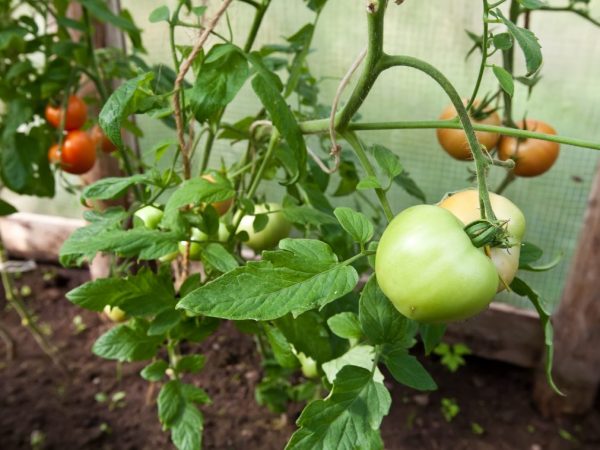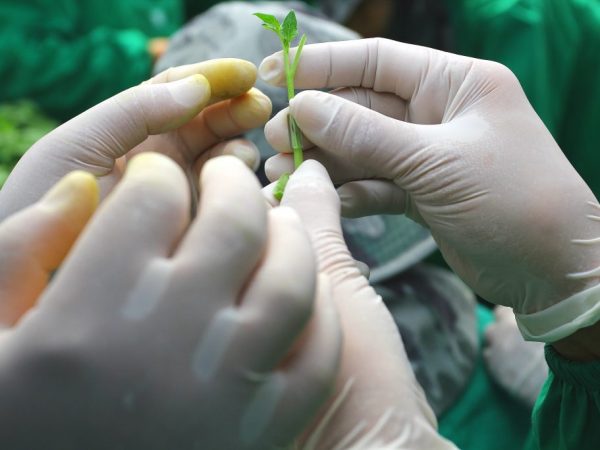How and why are tomatoes grafted?
Grafting tomatoes can protect bushes from disease and increase the amount of harvest. Let's consider how to properly carry out such a procedure.

Grafting tomatoes
The benefits of grafting tomatoes
Tomato grafting (copulation) is gaining more and more popularity. This method is perfect for gardeners with a small garden plot, where there is no way to plant a large number of bushes. Tomatoes can be grafted not only from variety to variety, but also by combining different varieties of nightshade.
Copulation not only helps to solve the problem of the area, but also benefits the bushes. It is used for several reasons:
- To improve the root system. A seedling with two roots receives more nutrients, and fruiting occurs earlier.
- To prevent disease.
- To increase yields. You can grow more valuable varieties of hybrids on less suitable ones.
- To increase resistance to temperature changes, the amount of watering and the condition of the soil.
This method is also suitable for northern vegetable growing areas. Bad weather and temperature drops make it difficult to get a large harvest from one bush, so copulating a vegetable makes it possible to collect the maximum yield from one bush.
When to vaccinate tomatoes
You can sow seeds in late February or early March. After 2-3 weeks, the seedlings must be dived: transplant 2 plants into separate pots or cups at a distance of 1-1.5 cm. When the seedlings reach 25 cm and the trunk thickness is 4 mm, you can start grafting. This happens about a month before the tomatoes are planted in the ground. The date is viewed according to the gardener's calendar.
The stem of the seedling should be round. If done later, the stem becomes flatter and the graft does not get along.
It is better to do splicing in cloudy weather. If it's sunny outside, then in the evening.
Tomato grafting methods
When grafted, each stem has its own name. A weak plant that is grafted onto another is called a stock. A stronger plant is called a scion. The process is called "ablation".
Tomatoes are grafted in several ways:
- "Rapprochement with the tongue";
- convergence in the same row in the garden.
In the southern regions, the digging method is used. With this method, the stem "lying down" is buried with earth, as a result of which new roots appear in the plant. The digging method is not suitable for northern latitudes due to the formation of new roots: the harvest may not fully ripen.
Tomatoes are planted not only of one variety. You can ablate seedlings of different colors: then on one bush there will be red and yellow fruits.
Ablactation with tongue

Ablating will increase yields
You will need a blade, alcohol or other disinfectant, scissors, and tape (strong thread, cloth). Hands are disinfected before work.
This technique is used when 3-4 leaves are formed on the seedlings. Let's take a closer look at how to properly plant tomatoes:
- Above the cotyledon leaves, a sharp blade is used to cut a part of the stem 1.5 cm wide and 1.5 cm long.
- The cut is made at the same level for both plants.
- On the rootstock, a cut is made from top to bottom, and on the scion, on the contrary, from bottom to top.
- After removing the skin, splits or tongues are made with a depth of 6-7 mm.
- The tongues are inserted into each other and fixed.
They are held together so as not to pinch the stems. For fixing, electrical tape, strips of materials are suitable. It is better not to use polyethylene: it does not allow air to pass through, and roots form in that place.
After copulation, the plants are hidden in the shade. You can put plastic bags on top of the pots for 2 days to increase the humidity. The stems grow together within 2 weeks. After that, the fixing material is removed. At the rootstock, the crown is cut off just above the graft.
The trimmed crown is placed in water. After rooting, it is planted as normal seedlings. The crown does not have time to stretch, so the seedlings come out strong and stocky.
During grafting, it is recommended to spray water from a spray bottle. This improves the survival rate and increases the moisture content.
If you sow seeds one at a time in a pot, you do not need to pick. For splicing, individual pots with seedlings are pressed against each other, cuts are made and fixed. You need to fasten with a thread, the upper and lower turns should be above and below the sections to be connected. After that, the seedlings are removed in the shade. After 2 days, the seedlings are returned to the sun, a third of the leaves are removed from the stock, and the crown is pinched off. After 2 weeks, the stock is removed completely.
As a result of such actions, a seedling with two roots is obtained, which allows you to get more tomato harvest.
Convergence in the same row in the garden
The second way to copulate tomatoes is to converge in the same row in the garden. With this method, stepchildren of neighboring plants are spliced. For this, stepchildren are taken below the first brush. The rootstock and the scion are combined with "tongues" into one stem.
In order for the vegetable to grow in one stem, remove the tops from 2 stepsons. If it is supposed to be grown in 2 stems, pinch off the crown of the stock.
Care of grafted seedlings
Active fruiting and large fruits are provided not only by ablation, but also by high-quality plant care. Grafted seedlings develop faster due to the doubled root system, therefore, care must be appropriate:
- Where the stepsons come together, they remove the leaves. This improves the ventilation of the tomato lashes.
- A few leaves are left on the rootstocks to improve fruiting.
- Shoots in the leaf axils are removed.
- Plants that have reached 170-180 cm are pinched.
Spliced seedlings are watered with warm rainwater under the root, and not sprayed with water. For the best result, put plastic bottles with a cut-off bottom next to the bush.
Before the providence of ablactation, fasteners are installed to tie up the stepsons. They are tied up in 2 places: below and above the vaccination site. Each stem must be tied up to the junction. In the process of cultivation, the stem's toughness is loosened so that they do not cut into the plant.
If tomatoes are grown in a greenhouse, it is periodically ventilated. Do not allow moisture to accumulate on the walls.
Conclusion
Grafted tomatoes are more resistant to infections and diseases. You can even graft the culture to other vegetables: potatoes, peppers or eggplant.
Copulation is done with tomatoes, which are grown both in pots and in beds.


